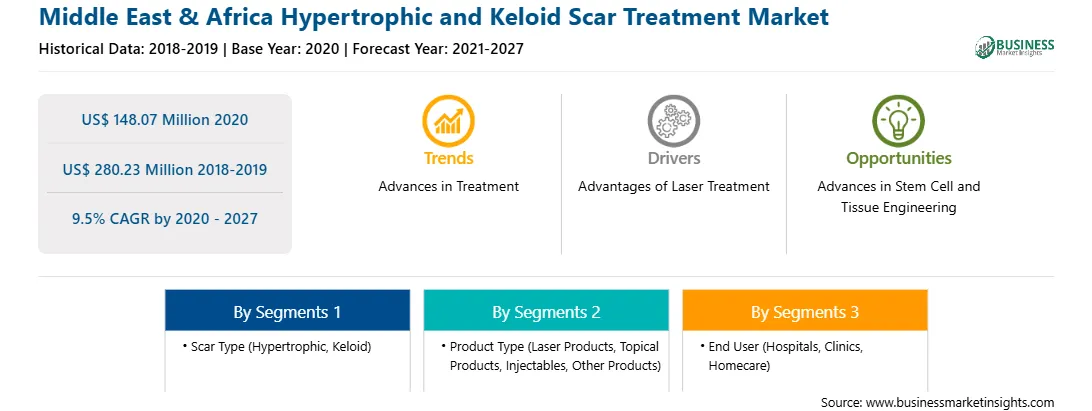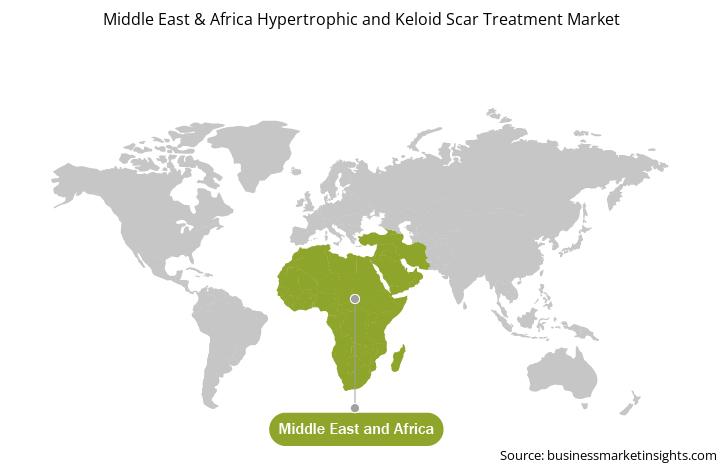Middle East & Africa consists of three major countries namely United Arab Emirates (UAE), Saudi Arabia and South Africa. The South Africa held the largest market share in 2019 followed by the Saudi Arabia. South Africa is estimated to be the fastest growing country in the region. Key growth aspect is rising focus on health-related infrastructure, public health, and primary healthcare. Moreover, other factors that are helping the market’s growth are increasing medical tourism in Middle East & Africa region and growing severe cases like burn injuries and others. There is a need for long-standing guidelines on the diagnosis and treatment of keloids and hypertrophic scars that are based on an understanding of the pathomechanisms that underlie these fibrotic skin diseases. This is true for clinicians who deal with Asian and African patients as these ethnicities are highly prone to keloids and hypertrophic scars diseases. Caucasians don't usually develop keloids and hypertrophic scars; even if they form, it is less likely to be severe. Population, especially from sub-Saharan Africans and African Americans, has a positive family history of keloid disorder. Moreover, in some cases, it is observed that the tendency to form keloids runs in families. Moreover, among twins, the credibility of the existence of a genetic susceptibility to develop keloids is also present. Such scars disproportionately affect African American, Latin American, and Asian populations, with a prevalence ranging from 0.3 to 16%. According to the Frontiers Media SA, in head and neck surgical patients as well as women after caesarian section, the incidence of keloid scar formation was significantly increased in African Americans (0.8 and 7.1%, respectively) compared with the Caucasian (0.1 and 0.5%, respectively). Based on above mentioned factors, the hypertrophic and keloid scar treatment market in the South Africa is likely to show significant growth over the forecasted period.
Africa has reported 2,867,078 cases as of early January 2021. The number of COVID-19 cases has been increasing in South Africa (1,113,349), Iran (1,249,507), and Turkey (2,255,607). Economic uncertainties and ongoing conflicts are worsening the situation in the region. For instance, countries such as Syria, Libya, and Yemen are experiencing violent conflict and cannot complete any public health measures. Iran was in a deep economic collapse due to the US sanctions. Till October 2020, there was a higher incidence of COVID-19 in Egypt and the Republic of South Africa than in the general picture in Africa. However, the level is low as compared to the US, the UK, and Italy. The Middle East countries have registered a growth in the number of COVID-19 cases in the last few days, with the UAE registering 106,229 cases, Saudi Arabia reporting 339,267, and South Africa indicating 692,471 confirmed cases. However, the hypertrophic and keloid scar treatment market in this pandemic is declining due to the reduced demand for dermatology treatments. The countries are mainly focused on treating COVID-19 patients, and hence, the appointments for the hypertrophic and keloid scar treatment are postponed.

Strategic insights for the Middle East & Africa Hypertrophic and Keloid Scar Treatment provides data-driven analysis of the industry landscape, including current trends, key players, and regional nuances. These insights offer actionable recommendations, enabling readers to differentiate themselves from competitors by identifying untapped segments or developing unique value propositions. Leveraging data analytics, these insights help industry players anticipate the market shifts, whether investors, manufacturers, or other stakeholders. A future-oriented perspective is essential, helping stakeholders anticipate market shifts and position themselves for long-term success in this dynamic region. Ultimately, effective strategic insights empower readers to make informed decisions that drive profitability and achieve their business objectives within the market.

| Report Attribute | Details |
|---|---|
| Market size in 2020 | US$ 148.07 Million |
| Market Size by 2027 | US$ 280.23 Million |
| Global CAGR (2020 - 2027) | 9.5% |
| Historical Data | 2018-2019 |
| Forecast period | 2021-2027 |
| Segments Covered |
By Scar Type
|
| Regions and Countries Covered | Middle East and Africa
|
| Market leaders and key company profiles |
The geographic scope of the Middle East & Africa Hypertrophic and Keloid Scar Treatment refers to the specific areas in which a business operates and competes. Understanding local distinctions, such as diverse consumer preferences (e.g., demand for specific plug types or battery backup durations), varying economic conditions, and regulatory environments, is crucial for tailoring strategies to specific markets. Businesses can expand their reach by identifying underserved areas or adapting their offerings to meet local demands. A clear market focus allows for more effective resource allocation, targeted marketing campaigns, and better positioning against local competitors, ultimately driving growth in those targeted areas.

The hypertrophic and keloid scar treatment market in Middle East & Africa is expected to grow from US$ 148.07 million in 2020 to US$ 280.23 million by 2027; it is estimated to grow at a CAGR of 9.5% from 2020 to 2027. Tapping market in emerging countries; emerging region such as Africa have reported a maximum number of burn cases. According to the WHO, globally, ~180,000 deaths are reported due to burns, and African region account for the one-third of the total burn fatalities. However, there are several disparities in hypertrophic and keloid scars treatments across these regions. The treatment procedures are mainly based on the understanding of the pathological mechanisms that underlie these fibrotic skin diseases. The disparities due to ethnicities create challenges for the physicians to prescribe a treatment. In addition, uncertain diagnostics and unclear treatment guidelines may also lead to disparities offering treatments to people with different pathological of genetic makeup. Hence, a particular treatment may result in different outcomes. Therefore, disparities in the treatment procedures are likely to offer vital growth opportunities for the hypertrophic and keloid scar treatment market players to expand their business. This is bolstering the growth of the hypertrophic and keloid scar treatment market.
Based on scar type, the hypertrophic and keloid scar treatment market is segmented into hypertrophic and keloid. The hypertrophic segment held the largest share of the market in 2019. Based on product type, the hypertrophic and keloid scar treatment market is segmented into laser products, topical products, injectables, and other products. The injectables segment held the largest share of the market in 2019. Based on end user, the hypertrophic and keloid scar treatment market is segmented into hospitals, clinics, and homecare. The hospitals segment held the largest share of the market in 2019.
A few major primary and secondary sources referred to for preparing this report on the hypertrophic and keloid scar treatment market in Middle East & Africa are company websites, annual reports, financial reports, national government documents, and statistical database, among others. Major companies listed in the report are Alliance Pharma PLC
The Middle East & Africa Hypertrophic and Keloid Scar Treatment Market is valued at US$ 148.07 Million in 2020, it is projected to reach US$ 280.23 Million by 2027.
As per our report Middle East & Africa Hypertrophic and Keloid Scar Treatment Market, the market size is valued at US$ 148.07 Million in 2020, projecting it to reach US$ 280.23 Million by 2027. This translates to a CAGR of approximately 9.5% during the forecast period.
The Middle East & Africa Hypertrophic and Keloid Scar Treatment Market report typically cover these key segments-
The historic period, base year, and forecast period can vary slightly depending on the specific market research report. However, for the Middle East & Africa Hypertrophic and Keloid Scar Treatment Market report:
The Middle East & Africa Hypertrophic and Keloid Scar Treatment Market is populated by several key players, each contributing to its growth and innovation. Some of the major players include:
The Middle East & Africa Hypertrophic and Keloid Scar Treatment Market report is valuable for diverse stakeholders, including:
Essentially, anyone involved in or considering involvement in the Middle East & Africa Hypertrophic and Keloid Scar Treatment Market value chain can benefit from the information contained in a comprehensive market report.